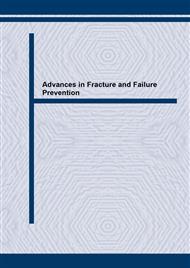p.1049
p.1055
p.1061
p.1067
p.1073
p.1079
p.1085
p.1091
p.1097
Fatigue Property and Fatigue Crack Propagation Behavior of Al2O3/A6061 MMCs at Room and Elevated Temperature
Abstract:
The rotating bending fatigue tests in high cycle region were carried out on alumina short fiber reinforced aluminum alloy composites (MMCs) at room and elevated temperatures of 200, 350, 400 and 450°C. The four kind of MMCs with 0%, 10%, 18% and 25% volume fraction were prepared in order to investigate the effects of alumina short fiber volume fraction on the fatigue property such as the fatigue strength, the crack initiation and propagation behaviors. As results, it was found that the fatigue strength at 107 cycles decreased with increase in the test temperature, but increased with an increase in alumina short fiber volume fraction at room and elevated temperatures. The crack initiation sites were large size alumina short fibers; some kind of cluster of short fibers and large size alumina particles (i.e. shots). And the crack growth paths were related to the distribution of the short fibers.
Info:
Periodical:
Pages:
1073-1078
Citation:
Online since:
April 2004
Authors:
Price:
Сopyright:
© 2004 Trans Tech Publications Ltd. All Rights Reserved
Share:
Citation:


